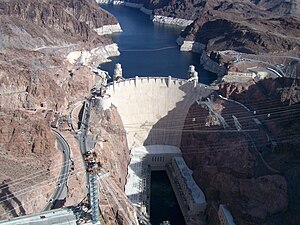

Hydroelectricity is, as of 2019, the second-largest renewable source of energy in both generation and nominal capacity (behind wind power) in the United States.[1] In 2021, hydroelectric power produced 31.5% of the total renewable electricity, and 6.3% of the total U.S. electricity.[2]
According to the International Hydropower Association, the United States is the 3rd largest producer of hydroelectric power in the world in 2021 after Brazil and China.[3] Total installed capacity for 2020 was 102,8 GW. The installed capacity was 80 GW in 2015. The amount of hydroelectric power generated is strongly affected by changes in precipitation and surface runoff.[4]
Hydroelectric stations exist in at least 34 US states. The largest concentration of hydroelectric generation in the US is in the Columbia River basin, which in 2012 was the source of 44% of the nation's hydroelectricity.[5] Hydroelectricity projects such as Hoover Dam, Grand Coulee Dam, and the Tennessee Valley Authority have become iconic large construction projects.
Of note, however, is that California does not consider power generated from large hydroelectric facilities (facilities greater than 30 megawatts) to meet its strictest definition of "renewable", due to concerns over the environmental impact of large hydroelectric projects. As such, electricity generated from large hydroelectric facilities does not count toward California's strict Renewable Portfolio Standards, even though other states recognize that water is a renewable resource in the hydrological cycle. Roughly about 10 to 15 percent of California's energy generation is from large hydroelectric generation that is not RPS-eligible.[6]
The significant impact of dams on the power sector, water use, river flow, and environmental concerns requires significant policy specific to hydropower.
- ^ "Renewable Tuesday: US Wind Surpasses Hydro". Daily Kos.
- ^ "Hydropower explained - U.S. Energy Information Administration (EIA)". www.eia.gov. Retrieved October 24, 2020.
- ^ https://assets-global.website-files.com/5f749e4b9399c80b5e421384/60c2207c71746c499c0cd297_2021%20Hydropower%20Status%20Report%20-%20International%20Hydropower%20Association%20Reduced%20file%20size.pdf.
{{cite web}}: Missing or empty|title=(help) - ^ US Energy Information Administration (January 2010) Electric Power Annual 2008, DOE/EIA-0348(2008), p.2-3, PDF file, downloaded 24 January 2010.
- ^ US Energy Information Administration, “The Columbia River Basin provides more than 40% of total US hydroelectric generation”, Today in Energy, 27 June 2014.
- ^ http://www.energy.ca.gov/renewables/tracking_progress/documents/renewable.pdf [bare URL PDF]
© MMXXIII Rich X Search. We shall prevail. All rights reserved. Rich X Search
